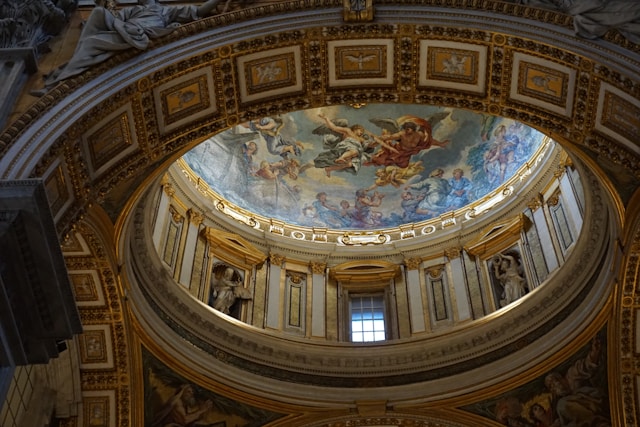St. Peter’s Cathedral, the grand patriarchal basilica in Vatican City, is not just an architectural marvel but a sacred symbol of Christianity. Its construction spanned centuries, leaving behind a rich history intertwined with the rise of the Catholic Church and the development of Western art.
A History of Sacred Ground
Constantine’s Basilica: The Genesis
In the 4th century AD, Emperor Constantine the Great, a convert to Christianity, ordered the construction of a basilica over the presumed tomb of Saint Peter, the first pope. This original basilica became a pilgrimage site, drawing countless faithful from afar.
Renaissance and Baroque Reconstruction
By the 15th century, the basilica was in ruins. Pope Julius II initiated its reconstruction in 1506, appointing the renowned architect Donato Bramante. The project continued under subsequent popes, with major contributions from Michelangelo, Bernini, and Maderno. The new cathedral was completed in 1626.
Architectural Splendor
The Façade
The imposing façade, designed by Carlo Maderno, features a colonnade of 284 Doric columns and pilasters, framing five portals. The central portal, known as the Holy Door, is opened only during Jubilee years.
The Dome
Michelangelo’s masterpiece, the dome of St. Peter’s, is a marvel of engineering and aesthetics. Its double shell creates an illusion of lightness, while its interior is adorned with vibrant mosaics depicting scenes from the life of Saint Peter and the resurrection of Christ.
The Nave and Aisle
The vast interior of the cathedral is divided into a nave and four aisles. The nave is flanked by massive piers that support the dome and feature statues of saints and popes. The aisles are lined with chapels, each adorned with exquisite artwork and religious relics.
Artistic Treasures
Michelangelo’s “Pietà”
One of the most poignant masterpieces in art history, Michelangelo’s “Pietà,” carved from a single block of marble, depicts the grieving Mary holding the body of Jesus after his crucifixion. It is located in the first Vatican Chapel to the right of the entrance.
Bernini’s “Baldacchino”
Gian Lorenzo Bernini’s bronze canopy, or “baldacchino,” stands over the main altar in the crossing of the transept. Its twisted columns, soaring height, and ornate details embody Baroque exuberance.
Papal Center and Place of Pilgrimage
The Papal Throne
The Papal Throne, located in the apse of the cathedral, is a symbol of papal authority. It is used by the Pope during important ceremonies and celebrations.
Pilgrimage Destination
St. Peter’s Cathedral has been a major pilgrimage destination for centuries. Pilgrims from all over the world visit the tomb of Saint Peter, pray in the sacred spaces, and admire the stunning artwork.
Visiting St. Peter’s Cathedral
Planning Your Visit
Admission to the cathedral is free, but there are fees for accessing certain areas, such as the dome and the Vatican Grottoes. It is recommended to book guided tours in advance to avoid long queues.
Dress Code and Security
Appropriate attire is required to enter the cathedral. Shoulders and knees should be covered. There are strict security checks, so be prepared to present your belongings for inspection.
Other Tips
- Allow ample time for your visit, as the cathedral is vast.
- Bring water and wear comfortable shoes.
- Respect the sacred nature of the space by maintaining silence and avoiding disruptions.
Conclusion
St. Peter’s Cathedral is a testament to human ingenuity, artistic brilliance, and deep faith. Its history, architecture, and artwork invite us to marvel at the grandeur of the human spirit. Whether you are a pilgrim, an art enthusiast, or simply a curious traveler, a visit to St. Peter’s Cathedral is an unforgettable experience that will leave you inspired and awestruck.



